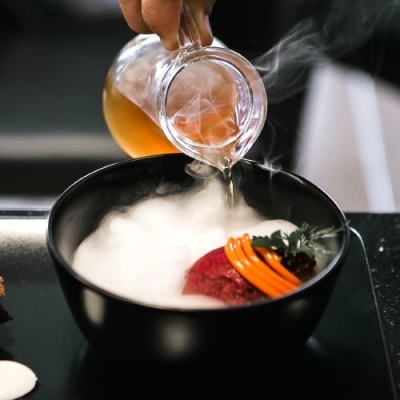What is molecular gastronomy?

Molecular gastronomy is a style of cooking in which chefs use scientific principles and technology to enhance the flavours and alter the textures of food. The term 'molecular gastronomy' was coined by Hungarian physicist Nicholas Kurti and French chemist Herve This in the 1980s. This genre of cooking involves specially trained chefs.
One of the well-known techniques is spherification. It is the process of shaping a liquid such as fruit juice into spheres. The liquid is first mixed with sodium alginate, a chemical. This mixture is then dripped, drop by drop, into a bowl of a cold solution of calcium chloride. Each drop turns into a small ball, called a ‘caviar’. When popped in the mouth, these fruit 'caviars' melt, delivering an intense taste.
Using liquid nitrogen to freeze dishes instantly is another technique. Liquid nitrogen has a temperature of -196°C (321°F). So when ice cream is made using this, it freezes very quickly. This reduces the formation of ice crystals, resulting in a creamier ice cream.
Special types of foams can also be created. Traditionally, foams are made with a whisk or an espresso machine (to make coffee froth). But in molecular gastronomy, the substance to be foamed is usually mixed with a stabiliser such as lecithin and then squeezed out through a whipped cream canister fitted with a nitrogen oxide capsule. With this technique, chefs can make truffle foam and top a meat dish with it or make pickle foam to top, well, even rice!
Bite size
Molecular gastronomy a scientific discipline that focusses on the physical and chemical transformations that occur during cooking.
Spotlight on egg
Molecular gastronomy kicked off renewed interest in eggs. It looked at how different cooking temperatures, altered viscosity or even introduction of air can enhance the taste and nutritive value of eggs.
Lab or a kitchen?
Here's a peek into what they use:
Carbon dioxide: For creating bubbles, foams.
Syringe: To fill food with unexpected flavours and fillings.
Maltodextrin: To convert high-fat liquids into a powder.
Liquid nitrogen: To freeze in a flash! Create a shattering effect on food.
Techniques used
Some of the common techniques used are emulsification, smoking, spherification, deconstruction, gelification, meat gluing, flash freezing and creating edible paper.
Picture Credit : Google